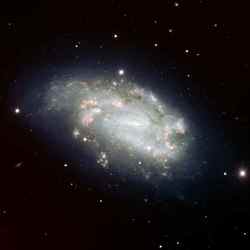
Supernova 2005dh and NGC 1559. Image credit: ESO Click to enlarge
The southern Reticulum constellation certainly isn’t a big hit for amateur astronomers. This tiny, bleak and diamond-shaped constellation, not far on the sky from the Large Magellanic Cloud, is often overlooked. But recently, astronomers had a closer look at a galaxy situated inside it. And more precisely at an exploding star hosted by the spiral galaxy NGC 1559.
On the night of August 4, 2005, Australian amateur astronomer Reverend Robert Evans discovered a supernova just North of the galaxy with his 0.31-m telescope. The supernova – the explosion of a star – was of magnitude 13.8, that is, only 20 times fainter than the entire host galaxy. Being the 104th supernova discovered in 2005, it received the name SN 2005df. Noticeably, Evans had already discovered 2 other supernovae in the same galaxy: in 1984 (SN 1984J) and in 1986 (SN 1986L).
The following night, astronomer Marilena Salvo and her Australian colleagues classified the supernova as a somewhat unusual type Ia supernova, caught probably 10 days before it reached its maximum brightness. Such a supernova is thought to be the result of the explosion of a small and dense star – a white dwarf – inside a binary system. As its companion was continuously spilling matter onto the white dwarf, the white dwarf reached a critical mass, leading to a fatal instability and the supernova.
These are exactly a kind of supernovae in which Dietrich Baade, Ferdinando Patat (ESO), Lifan Wang (Lawrence Berkeley National Laboratory, USA), and their colleagues are interested. In particular, they study the polarization properties of this kind of supernova in order to learn more about their asphericity, which holds important clues to the detailed physics that governs this terminal catastrophe in the life of such stars.
Having an accepted observing programme that uses the FORS1 multi-mode instrument on Kueyen, one of the four Unit Telescopes of ESO’s 8.2m Very Large Telescope at Cerro Paranal, they triggered a Target of Opportunity request so that on-duty astronomers at the VLT could observe this supernova, which was done on August 6.
From a very first analysis of their data, Wang and his colleagues found that SN 2005df resembles closely another supernova they had studied before, SN 2001el, whose explosion they showed was significantly asymmetric.
NGC 1559 is a SBc(s)-type spiral galaxy located about 50 million light-years away, that weighs the equivalent of about 10,000 million of suns, and is about 7 times smaller than our Milky Way: on the sky, it measures about 4×2 arcmin2. Receding from us at a speed of about 1,300 km/s, it is a galaxy of the Seyfert type. Such galaxies are characterized by a bright nucleus that radiates strongly in the blue and in the ultraviolet. Astronomers think that about 2 solar masses of gas per year are transformed into stars in this galaxy. Like most galaxies, NGC 1559 probably contains a black hole in its centre, which should have a mass that is equivalent to 300,000 suns.
Original Source: ESO News Release
